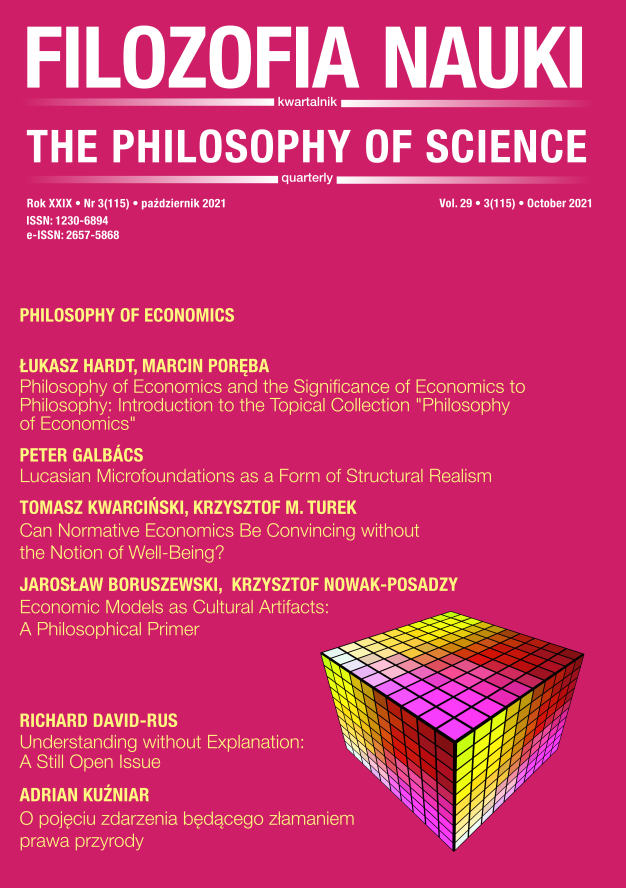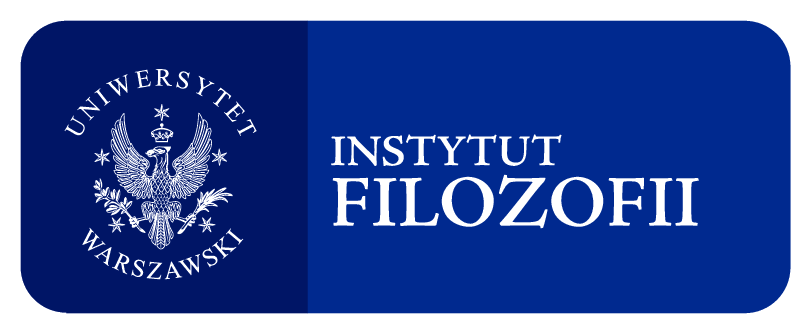Lucasian Microfoundations as a Form of Structural Realism
DOI:
https://doi.org/10.14394/filnau.2021.0003Słowa kluczowe:
Robert E. Lucas, business cycle theory, microfoundations, entity realism, structural realism, semirealismAbstrakt
This paper is an attempt to understand Robert E. Lucas’s microfounded models of the 1960-70s as results of a structuralist project. It is argued that the way Lucas derived macroeconomic outcomes from the decisions of market agents is in line with the basic tenet of the semirealist version of structural realism, where structures are conceived as relations emerging between properties of relata under specific conditions. Accordingly, after an overview of semirealism, it is emphasized that in his microfoundations project Lucas formulated the basic decision problem so that large-scale fluctuations could plausibly be traced back to agents’ properties. The transition from Lucas and Rapping’s model of the labor market to Lucas’s monetary island model is described as placing the same decision makers in a setting the specifics of which are in consonance with the assumed actions and interactions of market participants.
Bibliografia
Blaug M. (1992), The Methodology of Economics or How Economists Explain (2nd ed.), Cambridge: Cambridge University Press. https://doi.org/10.1017/CBO9780511528224
Cao T. Y. (2006), “Structural Realism and Quantum Gravity” [in:] The Structural Foundations of Quantum Gravity, D. Rickles, S. French, J. Saatsi (eds.), Oxford: Clarendon Press, 40-52. https://doi.org/10.1093/acprof:oso/9780199269693.003.0002
Castellani E. (1993), “Quantum Mechanics, Objects and Objectivity” [in:] The Foundations of Quantum Mechanics: Historical Analysis and Open Questions, C. Garola, A. Rossi (eds.), Dordrecht: Kluwer, 105-114. https://doi.org/10.1007/978-94-011-0029-8_9
Chakravartty A. (1998), “Semirealism,” Studies in History and Philosophy of Science Part A 29(3), 391-408. https://doi.org/10.1016/s0039-3681(98)00013-2
Chakravartty A. (2003), “The Structuralist Conception of Objects,” Philosophy of Science 70(5), 867-878. https://doi.org/10.1086/377373
Chakravartty A. (2004), “Structuralism as a Form of Scientific Realism,” International Studies in the Philosophy of Science 18(2-3), 151-171. https://doi.org/10.1080/0269859042000296503
Chakravartty A. (2007), A Metaphysics for Scientific Realism: Knowing the Unobservable, Cambridge: Cambridge University Press. https://doi.org/10.1017/CBO9780511487354
Chakravartty A. (2012), “Ontological Priority: The Conceptual Basis of Non-eliminative, Ontic Structural Realism” [in:] Structural Realism: Structure, Object, and Causality, E. M. Landry, D. P. Rickles (eds.), New York: Springer, 187-206. https://doi.org/10.1007/978-94-007-2579-9_10
Chakravartty A. (2017a), “Case Studies, Selective Realism, and Historical Evidence” [in:] EPSA15 Selected Papers. The 5th Conference of the European Philosophy of Science Association in Düsseldorf, M. Massimi, J. W. Romeijn, G. Schurz (eds.), Heidelberg: Springer, 13-23. https://doi.org/10.1007/978-3-319-53730-6_2
Chakravartty A. (2017b), “Saving the Scientific Phenomena: What Powers Can and Cannot Do” [in:] Putting Powers to Work, J. J. Jacobs (ed.), Oxford: Oxford University Press, 24-37. https://doi.org/10.1093/oso/9780198796572.003.0003
Contessa G. (2007), “Representation, Interpretation, and Surrogative Reasoning,” Philosophy of Science 74(1), 48-68. https://doi.org/10.1086/519478
De Vroey M. (2016), A History of Macroeconomics from Keynes to Lucas and Beyond, Cambridge: Cambridge University Press. https://doi.org/10.1017/CBO9780511843617
Debreu G. (1974), “Excess Demand Functions,” Journal of Mathematical Economics 1(1), 15-21. https://doi.org/10.1016/0304-4068(74)90032-9
Ellis B. (1991), “Scientific Essentialism” (paper presented at the 1991 Conference of the Australasian Association for the History and Philosophy of Science).
Ellis B. (2008), “Powers and Dispositions” [in:] Revitalizing Causality: Realism about Causality in Philosophy and Social Science, R. Groff (ed.), London: Routledge, 76-92. https://doi.org/10.4324/9780203932636
Elsamahi M. (1994), “Could Theoretical Entities Save Realism?,” Proceedings of the Biennial Meeting of the Philosophy of Science Association 1994(1), 173-180. https://doi.org/10.2307/193022
Epstein B. (2009), “Ontological Individualism Reconsidered,” Synthese 166(1), 187-213. https://doi.org/10.1007/s11229-007-9272-8
Epstein B. (2014), “Why Macroeconomics Does Not Supervene on Microeconomics,” Journal of Economic Methodology 21(1), 3-18. https://doi.org/10.1080/1350178X.2014.886467
Esfeld M. (2009), “The Modal Nature of Structures in Ontic Structural Realism,” International Studies in the Philosophy of Science 23(2), 179-194. https://doi.org/10.1080/02698590903006917
Esfeld M. (2013), “Ontic Structural Realism and the Interpretation of Quantum Mechanics,” European Journal for Philosophy of Science 3(1), 19-32. https://doi.org/10.1007/s13194-012-0054-x
French S. (1998), “On the Withering Away of Physical Objects” [in:] Interpreting Bodies: Classical and Quantum Objects in Modern Physics, E. Castellani (ed.), Princeton:
Princeton University Press, 93-113. https://doi.org/10.1515/9780691222042-009
French S. (2010), “The Interdependence of Structure, Objects and Dependence,” Synthese 175(S1), 89-109. https://doi.org/10.1007/s11229-010-9734-2
French S., Ladyman J. (2011), “In Defence of Ontic Structural Realism” [in:] Scientific Structuralism, A. Bokulich, P. Bokulich (eds.), New York: Springer, 25-42. https://doi.org/10.1007/978-90-481-9597-8_2
Friedman M. (1968), “The Role of Monetary Policy,” The American Economic Review 58(1), 1-17.
Friedman M., Schwartz A. J. (1963), A Monetary History of the United States, 1867-1960, Princeton: Princeton University Press.
Galbács P. (2015), The Theory of New Classical Macroeconomics: A Positive Critique, New York: Springer. https://doi.org/10.1007/978-3-319-17578-2
Galbács P. (2020), The Friedman-Lucas Transition in Macroeconomics: A Structuralist Approach, Cambridge, MA: Elsevier Science. https://doi.org/10.1016/C2018-0-00273-X
Garfinkel A. (1981), Forms of Explanation: Rethinking the Questions in Social Theory, New Haven: Yale University Press.
Hacking I. (1982), “Experimentation and Scientific Realism,” Philosophical Topics 13(1), 71-87. https://doi.org/10.5840/philtopics19821314
Hardin C. L., Rosenberg A. (1982), “In Defense of Convergent Realism,” Philosophy of Science 49(4), 604-615. https://doi.org/10.1086/289080
Hardt Ł. (2018), “Economic Models and Ceteris Normalibus Laws,” Economic Studies 2018(1-2), 41-70.
Hoover K. D. (2001), “Is Macroeconomics for Real?” [in:] The Economic World View: Studies in the Ontology of Economics, U. Mäki (ed.), Cambridge: Cambridge University Press, 225-245. https://doi.org/10.1017/CBO9780511752049.013
Hoover K. D. (2008), “Does Macroeconomics Need Microfoundations?” [in:] The Philosophy of Economics: An Anthology, D. M. Hausman (ed.), Cambridge: Cambridge University Press, 315-333. https://doi.org/10.1017/CBO9780511819025.022
Hoover K. D. (2009), “Microfoundations and the Ontology of Macroeconomics” [in:] The Oxford Handbook of Philosophy of Economics, H. Kincaid, D. Ross (eds.), Oxford: Oxford University Press, 386-409. https://doi.org/10.1093/oxfordhb/9780195189254.003.0014
Hoover K. D. (2012), “Microfoundational Programs” [in:] Microfoundations Reconsidered: The Relationship of Micro and Macroeconomics in Historical Perspective, P. G. Duarte, G. T. Lima (eds.), Cheltenham: Edward Elgar, 19-61. https://doi.org/10.4337/9781781004104.00008
Kincaid H. (2008), “Structural Realism and the Social Sciences,” Philosophy of Science 75(5), 720-731. https://doi.org/10.1086/594517
Kirman A. P. (1992), “Whom or What Does the Representative Individual Represent?,” Journal of Economic Perspectives 6(2), 117-136. https://doi.org/10.1257/jep.6.2.117
Ladyman J. (1998), “What is Structural Realism?,” Studies in History and Philosophy of Science Part A 29(3), 409-424. https://doi.org/10.1016/s0039-3681(98)80129-5
Lucas R. E. (1964), Substitution between Labor and Capital in U.S. Manufacturing, 1929-1958. Unpublished Ph.D. Dissertation, Chicago: The University of Chicago.
Lucas R. E. (1965/1981), “Distributed Lags and Optimal Investment Policy” [in:] Rational Expectations and Econometric Practice, R. E. Lucas, T. J. Sargent (eds.), Minneapolis: University of Minnesota Press, 39-54.
Lucas R. E. (1967a), “Optimal Investment Policy and the Flexible Accelerator,” International Economic Review 8(1), 78-85. https://doi.org/10.2307/2525383
Lucas R. E. (1967b), “Adjustment Costs and the Theory of Supply,” Journal of Political Economy 75(4), 321-334. https://doi.org/10.1086/259289
Lucas R. E. (1969), “Capital-Labor Substitution in U.S. Manufacturing” [in:] The Taxation of Income from Capital, A. C. Harberger, M. J. Bailey (eds.), Washington, DC: The Brookings Institution, 223-274.
Lucas R. E. (1972), “Expectations and the Neutrality of Money,” Journal of Economic Theory 4(2), 103-124. https://doi.org/10.1016/0022-0531(72)90142-1
Lucas R. E. (1973/1976), “Econometric Policy Evaluation: A Critique,” Carnegie-Rochester Conference Series on Public Policy 1976(1), 19-46. https://doi.org/10.1016/S0167-2231(76)80003-6
Lucas R. E. (1977), “Understanding Business Cycles,” Carnegie-Rochester Conference Series on Public Policy 1977(5), 7-29. https://doi.org/10.1016/0167-2231(77)90002-1
Lucas R. E. (1980), “Methods and Problems in Business Cycle Theory,” Journal of Money, Credit and Banking 12(4), 696-715. https://doi.org/10.2307/1992030
Lucas R. E. (1981), Studies in Business-Cycle Theory, Oxford: Basil Blackwell.
Lucas R. E. (1986), “Adaptive Behavior and Economic Theory,” Journal of Business 59(4), S401-S426. https://doi.org/10.1086/296377
Lucas R. E. (1994), “Review of Milton Friedman and Anna J. Schwartz’s ‘A Monetary History of the United States, 1867-1960’,” Journal of Monetary Economics 34(1), 5-16. https://doi.org/10.1016/0304-3932(94)90055-8
Lucas R. E. (2004), “My Keynesian Education,” History of Political Economy 36(5), 12-24. https://doi.org/10.1215/00182702-36-Suppl_1-12
Lucas R. E. (1960-2004 and undated), Unpublished papers. Archival material stored at the David M. Rubenstein Library, Duke University.
Lucas R. E., Rapping L. A. (1969a), “Price Expectations and the Phillips Curve,” The American Economic Review 59(3), 342-350.
Lucas R. E., Rapping L. A. (1969b), “Real Wages, Employment, and Inflation,” Journal of Political Economy 77(5), 721-754. https://doi.org/10.1086/259559
Lucas R. E., Rapping L. A. (1972), “Unemployment in the Great Depression: Is There a Full Explanation?,” Journal of Political Economy 80(1), 186-191. https://doi.org/10.1086/259872
Lucas R. E., Sargent T. J. (1979), “After Keynesian Macroeconomics,” Federal Reserve Bank of Minneapolis Quarterly Review 3(2), 1-16. https://doi.org/10.21034/qr.321
Mäki U. (1992), “On the Method of Isolation in Economics” [in:] Intelligibility and Science, C. Dilworth (ed.), Amsterdam: Rodopi, 317-351.
Manicas P. T. (2006), A Realist Philosophy of Social Science: Explanation and Understanding, Cambridge: Cambridge University Press. https://doi.org/10.1017/CBO9780511607035
Mantel R. R. (1973), “On the Characterization of Aggregate Excess Demand,” Journal of Economic Theory 7(3), 348-353. https://doi.org/10.1016/0022-0531(74)90100-8
Morganti M. (2004), “On the Preferability of Epistemic Structural Realism,” Synthese 142(1), 81-107. https://doi.org/10.1023/B:SYNT.0000047712.39407.c3
Morrison M. (1990), “Theory, Intervention and Realism,” Synthese 82(1), 1-22. https://doi.org/10.1007/BF00413667
Phelps E. S. (ed.) (1970), The Microeconomic Foundations of Employment and Inflation Theory, New York: W. W. Norton.
Psillos S. (1995), “Is Structural Realism the Best of Both Worlds?,” Dialectica 49(1), 15-46. https://doi.org/10.1111/j.1746-8361.1995.tb00113.x
Psillos S. (2001), “Is Structural Realism Possible?,” Philosophy of Science 68(3), S13-S24. https://doi.org/10.1086/392894
Resnik D. B. (1994), “Hacking’s Experimental Realism,” Canadian Journal of Philosophy 24(3), 395-412. https://doi.org/10.1080/00455091.1994.10717376
Ross D. (2008), “Ontic Structural Realism and Economics,” Philosophy of Science 75(5), 732-743. https://doi.org/10.1086/594518
Sargent T. J. (1977), Is Keynesian Economics a Dead End? Working Paper, No. 101, Minnesota: University of Minnesota. https://doi.org/10.21034/wp.101
Simon H. A. (1969/1996), The Sciences of the Artificial, Cambridge, MA: The MIT Press.
Sonnenschein H. (1972), “Market Excess Demand Functions,” Econometrica 40(3), 549-563. https://doi.org/10.2307/1913184
Sonnenschein H. (1973), “Do Walras’ Identity and Continuity Characterize the Class of Community Excess Demand Functions?,” Journal of Economic Theory 6(4), 345-354. https://doi.org/10.1016/0022-0531(73)90066-5
Stanford P. K. (2003), “Pyrrhic Victories for Scientific Realism,” The Journal of Philosophy 100(11), 553-572.
Stigler G. J. (1961), “The Economics of Information,” Journal of Political Economy 69(3), 213-225. https://doi.org/10.1086/258464
Stigler G. J. (1962), “Information in the Labor Market,” Journal of Political Economy 70(5), 94-105. https://doi.org/10.1086/258727
Suárez M. (2002), The Pragmatics of Scientific Representation. Centre for Philosophy of Natural and Social Science (CPNSS) Discussion Paper Series, DP 66/02, London: CPNSS/London School of Economics.
Suárez M. (2004), “An Inferential Conception of Scientific Representation,” Philosophy of Science 71(5), 767-779. https://doi.org/10.1086/421415
Swoyer C. (1991), “Structural Representation and Surrogative Reasoning,” Synthese 87(3), 449-508. https://doi.org/10.1007/BF00499820
Tobin J. (1952), “Money Wage Rates and Employment” [in:] The New Economics: Keynes’ Influence on Theory and Public Policy, S. E. Harris (ed.), New York: Knopf, 572-590.
van Fraassen B. (2007), “Structuralism(s) about Science: Some Common Problems,” Aristotelian Society Supplementary Volume 81(1), 45-61. https://doi.org/10.1111/j.1467-8349.2007.00150.x
Worrall J. (1989), “Structural Realism: The Best of Both Worlds,” Dialectica 43(1-2), 99-124. https://doi.org/10.1111/j.1746-8361.1989.tb00933.x



















 Filozofia Nauki | ISSN 1230-6894 | e-ISSN 2657-5868
Filozofia Nauki | ISSN 1230-6894 | e-ISSN 2657-5868